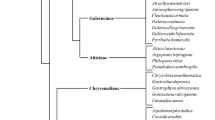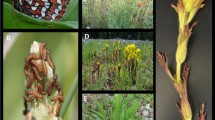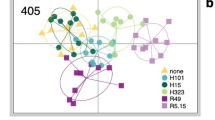Abstract
It is generally believed that animals make decisions about the selection of mates, kin or food on the basis of pre-constructed recognition templates. These templates can be innate or acquired through experience1. An example of an acquired template is the feeding preference exhibited by larvae of the moth, Manduca sexta. Naive hatchlings will feed and grow successfully on many different plants or artificial diets, but once they have fed on a natural host they become specialist feeders2,3,4,5,6. Here we show that the induced feeding preference of M. sexta involves the formation of a template to a steroidal glycoside, indioside D, that is present in solanaceous foliage. This compound is both necessary and sufficient to maintain the induced feeding preference. The induction of host plant specificity is at least partly due to a tuning of taste receptors to indioside D. The taste receptors of larvae fed on host plants show an enhanced response to indioside D as compared with other plant compounds tested.
This is a preview of subscription content, access via your institution
Access options
Subscribe to this journal
Receive 51 print issues and online access
$199.00 per year
only $3.90 per issue
Buy this article
- Purchase on Springer Link
- Instant access to full article PDF
Prices may be subject to local taxes which are calculated during checkout



Similar content being viewed by others
References
Sherman, P. W., Reeve, H. K. & Pfenning, D. W. in Behavioral Ecology An Evolutionary Approach (eds Krebs, J. R. & Davies, N. B.) 69–96 (Blackwell Science, Oxford, 1997).
Schoonhoven, L. M. Loss of host plant specificity by Manduca sexta after rearing on an artificial diet. Entomol. Exp. Appl. 10, 270–272 (1967).
Jermy, T., Hanson, F. E. & Dethier, V. G. Induction of specific food preference in lepidopterous larvae. Entomol. Exp. Appl. 47, 211–230 (1967).
Yamamoto, R. T. & Fraenkel, G. S. The specificity of the tobacco hornworm, Protoparce sexta, to solanaceous plants. Ann. Entomol. Soc. Am. 53, 503–507 (1960).
Yamamoto, R. T. Induction of hostplant specificity in the tobacco hornworm, Manduca sexta. J. Insect Physiol. 20, 641–650 (1974).
Mechaber, W. L. & Hildebrand, J. G. Novel non-solanaceous host plant record for Manduca sexta (Lepidoptera: Sphingidae) in the southwestern United States. Ann. Entomol. Soc. Am. 93, 447–451 (2000).
Bell, R. A., Owens, C. D., Shapiro, M. & Tardif, J. R. in The Gypsy Moth: Research Toward Integrated Pest Management. (eds Doane, C. C. & McManus, M. L.) 599–633 (USDA-FS Technical Bulletin 1584 (Washington DC, 1981).
Croasmun, W. A. & Carlson, R. M. K. (eds) Two-Dimentional NMR spectroscopy. Applications for Chemists and Biochemists 2nd edn (VCH, New York, 1994).
Yajara, S. et al. Steroidal glycosides, indiosides A–E, from Solanum indicum. Phytochemistry 43, 1319–1323 (1996).
Dethier, V. G. & Crnjar, R. M. Candidate codes in the gustatory system of caterpillars. J. Gen. Physiol. 79, 549–569 (1982).
Bernays, E. A. Selective attention and host-plant specialization. Entomol. Exp. Appl. 80, 125–131 (1996).
Waldbauer, G. P. & Fraenkel, G. Feeding on normally rejected plants by maxillectomized larvae of the tobacco hornworm, Protoparce sexta (Lepidoptera, Sphingidae). Ann. Ent. Soc. Am. 54, 477–485 (1961).
de Boer, G. Role of bilateral chemosensory input in food discrimination by Manduca sexta. Entomol. Exp. Appl. 61, 159–168 (1991).
de Boer, G. Effect of diet experience on the ability of different larval chemosensory organs to mediate food discrimination by the tobacco hornworm, Manduca sexta. J. Insect Physiol. 37, 763–769 (1991).
Flowers, R. W. & Yamamoto, R. T. Feeding on non-host plants by partially maxillectomized tobacco hornworms (Manduca sexta: Lepidoptera: Sphingidae). Florida Entomol. 75, 89–93 (1992).
de Boer, G. Plasticity in food preference and diet-induced differential weighting of chemosensory information in larval Manduca sexta. J. Insect Physiol. 12, 17–24 (1993).
Schoonhoven, L. M. & Dethier, V. G. Sensory aspects of host plant discrimination by lepidopterous larvae. Arch. Neder. Zool. 16, 497–530 (1966).
Schoonhoven, L. M. Sensitivity changes in some insect chemoreceptors and their effect on food selection behavior. Proc. K. Ned. Akad. Wet. C 72, 491–498 (1969).
Städler, E. & Hanson, F. E. in Host Plant in Relation to Insect Behavior and Reproduction (ed. Jermy, T.) 267–273 (Plenum, New York, 1976).
Abisgold, J. D. & Simpson, S. J. The effect of dietary protein levels and haemolymph composition on the sensitivity of maxillary palp chemoreceptors of locusts. J. Exp. Biol. 135, 215–229 (1988).
Glendinning, J. I., Ensslen, S., Eisenberg, E. & Weiskopf, P. Diet-induced plasticity in the taste system of an insect: localization to a single transduction pathway in an identified taste cell. J. Exp. Biol. 202, 2091–2102 (1999).
Rothschild, M., Aplin, R. & Marsh, N. Toxicity induced in the tobacco horn-worm (Manduca sexta L. ) (Sphingidae, Lepidoptera). Nature 280, 487–488 (1979).
Gothilf, S. E. & Hanson, F. E. Technique for electrophysiologically recording from sensory organs of intact caterpillars. Entomol. Axp. Appl. 72, 305–310 (1994).
Acknowledgements
We thank J. Ewer, K. Whitlock, D. Bodnar, C. Gilbert, P. Rivlin and J. Bestman for critical reviews of the manuscript; M. Haribal for preliminary NMR and MS; B. Johnson for equipment to analyse electrophysiological recordings; and J. Almadovar and M. Chu for help in the laboratory. This work was supported by grants from the NSF and the Binational Science Foundation to R.B., and the NSF to C.I.M.
Author information
Authors and Affiliations
Corresponding author
Rights and permissions
About this article
Cite this article
del Campo, M., Miles, C., Schroeder, F. et al. Host recognition by the tobacco hornworm is mediated by a host plant compound. Nature 411, 186–189 (2001). https://doi.org/10.1038/35075559
Received:
Accepted:
Issue Date:
DOI: https://doi.org/10.1038/35075559
This article is cited by
-
Chemosensory detection of glucosinolates as token stimuli for specialist insects on brassicaceous plants: discovery and impact
Journal of Comparative Physiology A (2024)
-
Cellular and molecular mechanisms of DEET toxicity and disease-carrying insect vectors: a review
Genes & Genomics (2020)
-
Specific Volatile Compounds from Mango Elicit Oviposition in Gravid Bactrocera dorsalis Females
Journal of Chemical Ecology (2014)
-
Species-Specific Effects of Herbivory on the Oviposition Behavior of the Moth Manduca sexta
Journal of Chemical Ecology (2013)
-
Prefeeding and Acceptance Behavior of an Oligophagous Beetle is Dependent on Plant Suitability and Rearing History
Journal of Insect Behavior (2012)
Comments
By submitting a comment you agree to abide by our Terms and Community Guidelines. If you find something abusive or that does not comply with our terms or guidelines please flag it as inappropriate.



